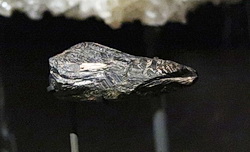
Rare-earth minerals, as the name suggests, are one of the most valuable natural commodities offered by the earth’s crust. Apart from being rare, these minerals have immense economic importance. For example, they are used in the manufacturing of the majority of electronic equipment that we use today.
Rare-earth minerals may contain any of the 13 metallic elements that are located on the second to last row of the periodic table. According to experts, they are abundantly present in the earth’s crust but in a dispersed form. This means it’s really hard to find deposits where these rare metallic elements are clumped together in an amount that can be mined for industrial purposes.
According to a research report published in the Journal of Nature, Japan might have discovered the world’s largest single deposit of rare-earth minerals on the coast of Minamitori Island over 1,100 miles southeast of Tokyo. It’s important to mention here that the discovery is still in its prospecting phase. However, what has been found until now is quite astonishing. It is safe to say that this discovery will have substantial implications for the high-end and complex manufacturing industries. First, let’s have a look at what geological and mineralogical experts have hinted about the deposit.
After the scientific prospecting of the site, researchers indicated that the deposit contains over 16 million tons of these rare-earth gems. Yes, you read that right. In the researchers’ own words, the amount of different rare-earth minerals present at the site can fulfill the global needs for a semi-infinite time period.
For example, it has been found out that there is enough yttrium and dysprosium on the site to fulfill the global needs of these metals for more than 700 years. Moreover, these europium deposits can last for more than 600 years. Terbium can be supplied for around 400 years from Minamitori Island mines.
Formation of Rare-Earth Minerals
Rare-earth minerals exist in the deepest layers of the earth’s crust. They move closer to the surface through tectonic and volcanic activity. It is believed that rare-earth minerals are the debris of a supernova explosion occurring millions of years ago, which then got integrated into the earth’s core upon its formation. Scientists believe that it is only natural to find such a large deposit of rare-earth minerals in Japan since the region experiences more volcanic activities and tectonic shifting than anywhere else in the world.
Economic Implications of the Discovery
China has a monopoly over the exports of rare-earth minerals and Japan is one of the largest consumers of this community, due to its expansive electronic manufacturing landscape. It has to rely on Chinese rare-earth imports to fulfill its industrial needs, but they have been guilty of abusing their authority over exports to Japan several times in the past.
For instance, it abruptly slashed the rare-mineral export quota to Japan and increased the price by 10 percent. In 2014, China withheld rare-earth mineral shipments to Japan over the issue of a disputed island between the two countries. The 2014 fiasco actually pushed Japan to start searching and prospecting rare-earth minerals on its own territory.
With the newly found deposits, Japan won’t have to bear with these shenanigans anymore. As mentioned earlier, the deposits are so enormous that they can fulfill the demand for several rare-earth minerals for centuries.
The discovery of the minerals in Japan has great economic prospects for the US as well. The United States is already in a trade war with China, where both countries are trying to damage the exports of the other. Successful mining of rare-earth minerals from Minamitori Island means the US can also drop one more Chinese import from the list in the future.
Challenge: Finding an Economic Excavation Method
The research further indicates that the difficult and expensive excavation is the major reason why Japan hasn’t already started mining in this area. According to the report writers, Japanese mineral experts are trying to work out an excavation technique that can turn the deposit mining into an economically viable project.
Uses of Rare-Earth Minerals Found in Japanese Site
To understand the significance of this discovery, let’s have a look at many the different uses that rare-earth minerals discovered on Minamitori Island can provide.
Yttrium
Yttrium is used as reinforcement in the making of magnesium and aluminum alloys. It is also used in the manufacturing of white LED lights. Yttrium is also in solid-state lasers, which are used to cut through metals. The radioactive isotopes of yttrium are used in some cancer treatments.
Dysprosium
The most significant use of dysprosium is seen in the manufacturing of control rods of nuclear reactors. It is used because of its remarkably good capability of absorbing neutrons. Moreover, its magnets are also used in motors and generators because of their exceptionally good resistance against temperature-derived demagnetization. Dysprosium is also used in the manufacturing of halide lamps since it produces intense white light.
Europium
Europium glows red under UV light. It is used in the printing of Euros to deter forgeries. A fake Euro banknote doesn’t give a reddish glow under UV lamps because of the absence of Europium from it. Europium is also used in really small amounts in the manufacturing of low-energy light bulbs. Moreover, some super-conducting alloys also contain the traces of europium.
Terbium
Terbium is used in the manufacturing of low-energy light bulbs. It is used in medical X-rays for quality improvement of images within short exposure time. Terbium basically makes the use of X-ray equipment safer. Its amorphous form is also used in the manufacturing of laser devices.
As the research into the excavation of these minerals without exhausting resource is still underway, it will easily take a couple of years before the industrial sector can benefit from this deposit. The Japanese track record regarding such developments is commendable. So, we should have a positive outlook regarding the optimal utilization of these rare-earth mineral deposits in the near future.
